Retirement planning is an essential aspect of financial management, yet it remains a challenging endeavor for many. Understanding the nuances of investment, market trends, and effective strategies is vital for a secure retirement.
This blog post explores key principles and strategies to help individuals build a robust retirement plan, emphasizing risk management and financial efficiency.
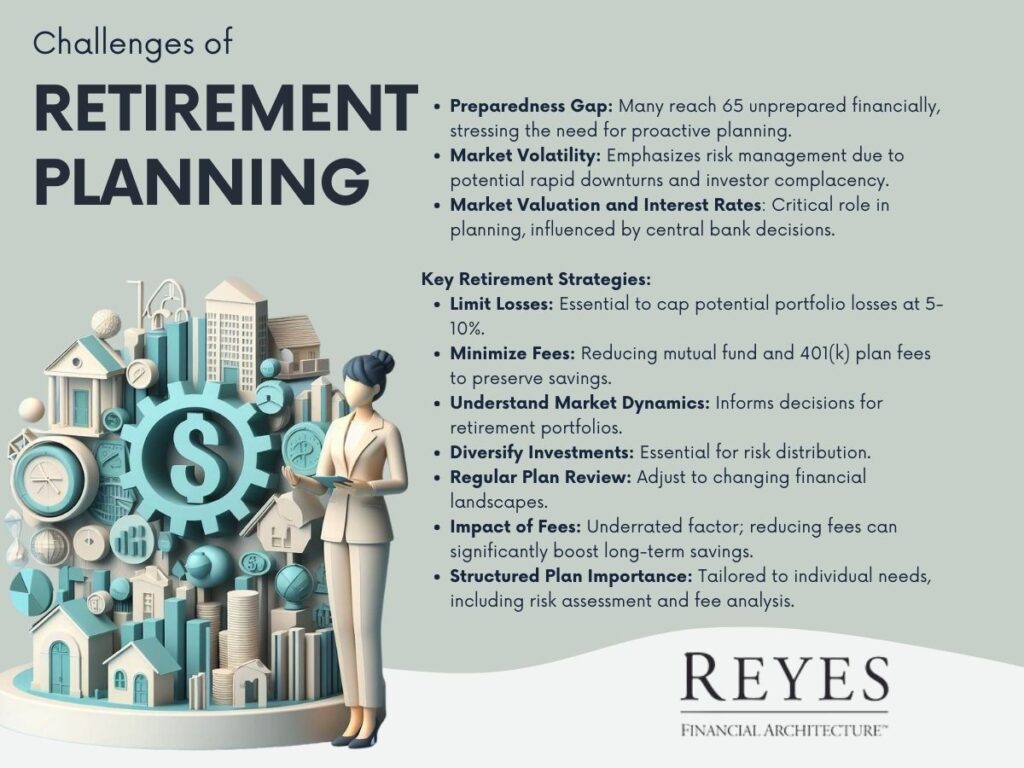
Statistics indicate a concerning trend: a large percentage of individuals reach the age of 65 without adequate financial resources, often relying on family or government support. This underscores the importance of proactive and strategic retirement planning, focusing on creating a guaranteed lifetime income.
Market volatility is a significant factor in retirement planning. Historical trends show substantial market downturns can occur rapidly, highlighting the need for a risk-aware investment approach. As time passes since major financial crises, there's a risk of investor complacency. Acknowledging and planning for potential market fluctuations is crucial in safeguarding retirement funds.
The valuation of the market, often influenced by decisions made by central banks like the Federal Reserve, especially regarding interest rates, plays a critical role in retirement planning. Overvaluation of the market and fluctuating earnings projections can impact investment strategies. Recognizing these factors can aid in making informed decisions for retirement portfolios.
To achieve a secure retirement, certain strategies and principles should be considered:
Additional strategies include understanding market dynamics, diversifying investments, and regularly reviewing and adjusting financial plans.
One often overlooked aspect of retirement planning is the impact of fees on long-term savings. Many individuals are unaware of the fees they incur, especially in investment products like mutual funds and employer-sponsored plans such as 401(k)s. Reducing these fees can lead to significant savings over time.
A structured retirement plan is critical. It should include a thorough risk assessment, an analysis of fees, and a comprehensive strategy tailored to individual needs and goals. A well-constructed plan provides clarity and a roadmap for achieving retirement objectives.
Effective retirement planning requires a multifaceted approach, balancing risk management, financial efficiency, and a deep understanding of market conditions. By adopting key strategies and maintaining a focus on long-term goals, individuals can enhance their chances of a financially secure retirement.
The process involves regular review and adaptation to changing circumstances, ensuring that retirement funds are not only accumulated but also protected and optimized for the long haul.
https://youtu.be/tYioyLxbNTI
Take a minute to watch this video for important information on long-term care, a topic everyone needs to be ahead of.
Long-term care (LTC) is a critical aspect of health and personal care that affects a significant portion of the population. Statistics indicate a high probability—around 70%—that an individual or their spouse will require long-term care at some point. This statistic underscores the importance of understanding what long-term care entails, its costs, and how to prepare for it.

Long-term care refers to a variety of services and supports tailored to meet an individual’s personal care needs over an extended period. Contrary to common misconceptions, most long-term care is not medical in nature. Instead, it predominantly involves assistance with everyday activities crucial for daily living.
Activities of Daily Living, or ADLs, are fundamental tasks that most people perform daily without assistance. These include:
Instrumental Activities of Daily Living, or IADLs, are tasks that are somewhat more complex than ADLs and are essential for independent living. These include:
The cost of long-term care can vary significantly based on several factors:
The initial premium level for long-term care insurance tends to increase with the age of the applicant. Younger individuals typically face lower premiums, highlighting the advantage of planning for long-term care early.
Qualifying for long-term care insurance becomes more challenging with age. Statistics show that 1 in 4 applicants between the ages of 60 and 69 do not qualify for such insurance. This statistic is a stark reminder of the importance of early planning.
Given the high likelihood of needing long-term care and the associated challenges and costs, it is crucial to understand the options and prepare adequately. This preparation is not just a personal matter but also a significant consideration for families.
Understanding and preparing for long-term care is a critical aspect of life planning. Given the high probability of needing such care, it’s prudent to start planning early. This includes understanding what long-term care entails, evaluating insurance options, and considering personal and family needs. By taking proactive steps today, individuals can ensure they have the support and resources they need to maintain their quality of life and independence in the future.
In today's rapidly evolving financial landscape, it's crucial to stay informed and vigilant about the state of the markets. Recently, an expert provided valuable insights on the current state of the market, emphasizing the unprecedented volatility that has gripped the financial world. In this article, we will delve into the reasons behind this cautionary stance and explore the factors contributing to the current market turmoil.
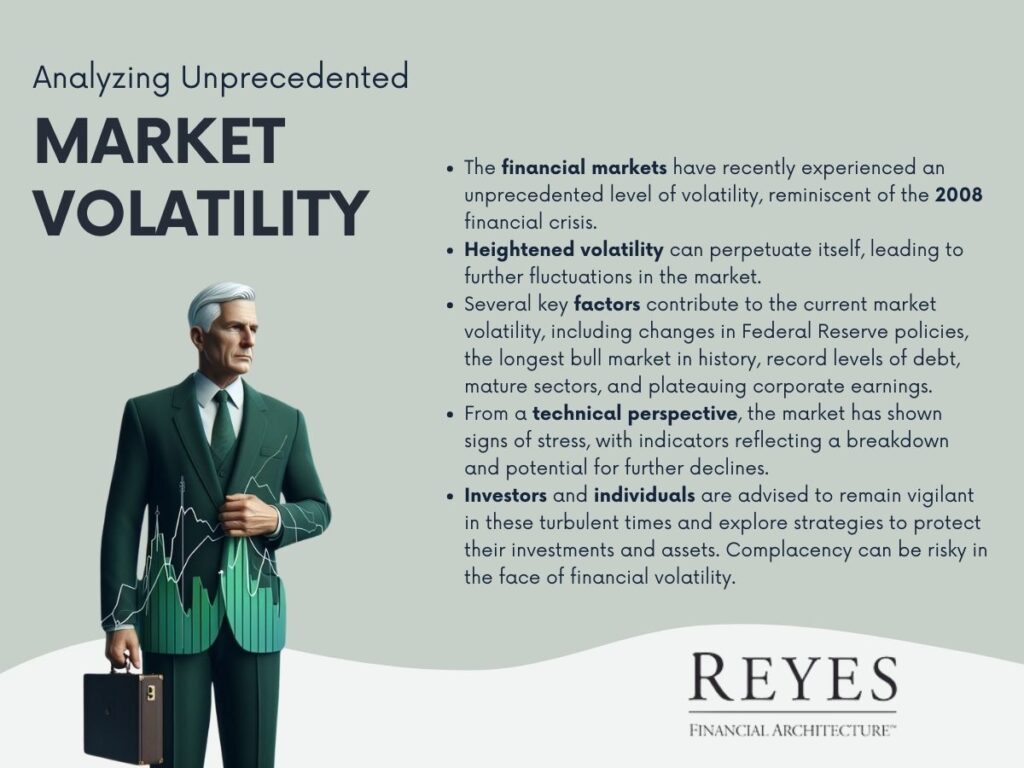
As noted, the financial markets have experienced an unusually high level of volatility in recent times, reminiscent of the tumultuous days of the 2008 financial crisis. This heightened level of market turbulence has not been witnessed since October 2008 and even 2010 came close to matching the current instability.
The adage that "volatility begets volatility" holds true in the financial world. When the market experiences significant fluctuations, it tends to perpetuate this trend. Over the last decade, investors grew accustomed to relative stability, which may have bred complacency. However, the current situation signals a shift in the market dynamics.
Several factors contribute to the heightened volatility observed in today's market:
From a technical perspective, the market has shown signs of stress not seen since 2008 and 2011, with indicators reflecting a breakdown. The S&P 500 is currently hovering around the 2600 level, reflecting a 10% drop from its peak. If the market breaks through this level, it could potentially decline to around 2,300, marking a 20% decline.
In conclusion, the recent market turbulence serves as a stark reminder that complacency in the face of financial volatility can be perilous. The combination of factors such as shifting Federal Reserve policies, an extended bull market, mounting debt levels, and plateauing corporate earnings has created a climate of uncertainty in the financial markets.
Investors and individuals alike would be wise to remain vigilant in these turbulent times. As market experts aptly put it, it's not the time to be complacent. Exploring strategies to protect investments and assets during these uncertain times may prove to be a prudent course of action.
In 1980, Ronald Reagan famously compared inflation to a violent mugger, a frightening armed robber, and a deadly hitman. During the tumultuous 1970s and early 1980s, inflation rates soared, averaging around 13.5%. This period of rampant inflation had a profound impact on the cost of goods, effectively doubling them within a decade.
While we might have experienced a reprieve from high inflation in recent years, it's crucial to recognize that it can rear its head once more. This article delves into the critical relationship between inflation and investing, highlighting the often-overlooked concept of the "perfect annuity" as a tool to combat the eroding effects of inflation in retirement.
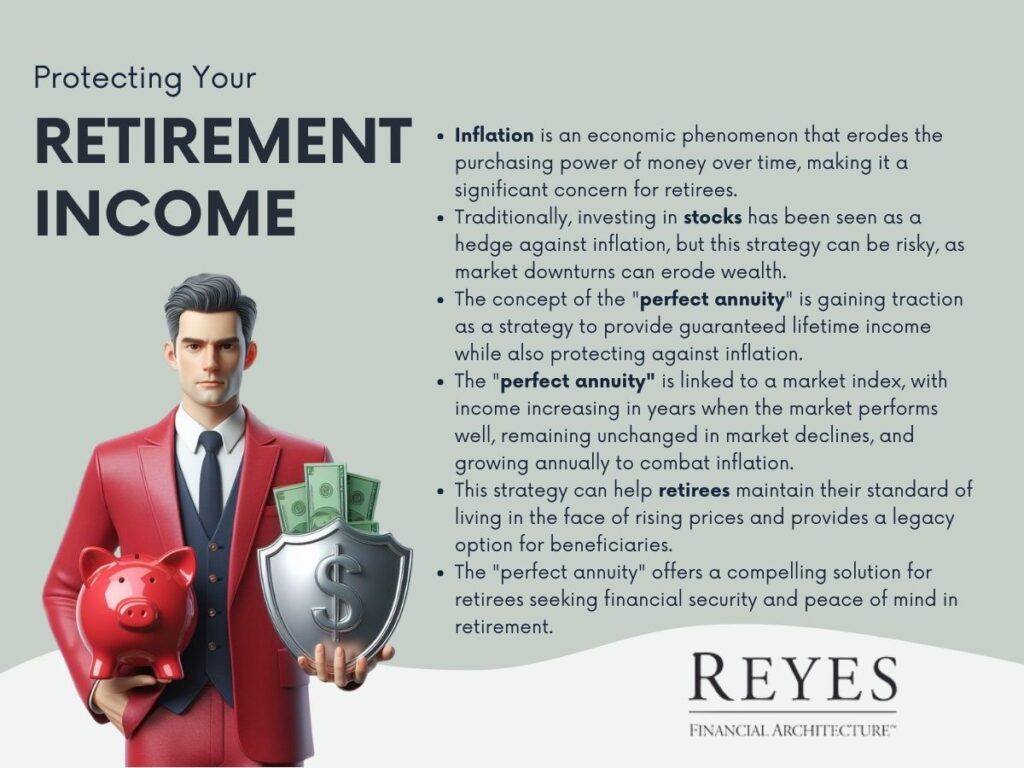
Inflation is an ever-present economic phenomenon that erodes the purchasing power of money over time. When you invest, especially in long-term assets like stocks, the goal is to outpace inflation and preserve the value of your wealth.
Traditionally, many have seen investing in stocks as a hedge against inflation, with the assumption that equities can generate returns that outpace the rising cost of living. However, this assumption doesn't always hold true, as evidenced by events like the 2008 financial crisis, which wiped out substantial portions of many portfolios.
Investors often face the challenge of ensuring that their income and wealth can withstand the corrosive effects of inflation, especially in retirement. While the concept of the "perfect annuity" may sound like an ideal solution, it remains a relatively obscure strategy. In this article, we aim to shed light on this innovative approach to safeguarding retirement income while simultaneously battling inflation.
The "perfect annuity" is a financial strategy designed to provide guaranteed lifetime income while also offering protection against inflation. This concept is gaining traction among financial advisors and retirees for its potential to address two significant retirement concerns: longevity risk and inflation risk.
Consider a scenario where an individual has a retirement portfolio of approximately $1 million. By strategically allocating a portion of this portfolio to a perfect annuity, they can secure an annual income for life. Over a 20-year period, assuming a conservative annual growth rate, their income will almost double, providing a reliable hedge against inflation.
One of the significant advantages of the perfect annuity is its resemblance to a pension. In most cases, when you choose a joint life expectancy option, both spouses can enjoy the same income benefits. Moreover, if there's a remaining balance upon the passing of the annuitant and their spouse, it can be passed on to beneficiaries, such as children, providing a legacy that many traditional annuities do not offer.
Inflation is an ever-present financial adversary, and safeguarding your retirement income against its erosive effects is paramount. The "perfect annuity" represents a powerful and relatively undiscovered tool in this battle.
By combining guaranteed lifetime income with the potential for income growth that keeps pace with inflation, this strategy offers a compelling solution for retirees seeking financial security and peace of mind.
It's a strategy worth considering as you plan for your retirement years and aim to ensure that your income not only lasts a lifetime but also remains resilient in the face of inflation's challenges.
Picture a scenario where you have a reliable pension plan that ensures a steady stream of income for both you and your spouse throughout your lifetimes. While this may seem like an enticing prospect, traditional pension plans often come up short in delivering such comprehensive financial benefits.
In this article, we will explore the concept of the perfect annuity, a financial instrument that combines the reliability of a pension with safeguards against inflation, offering a practical solution for those aiming for a secure retirement.
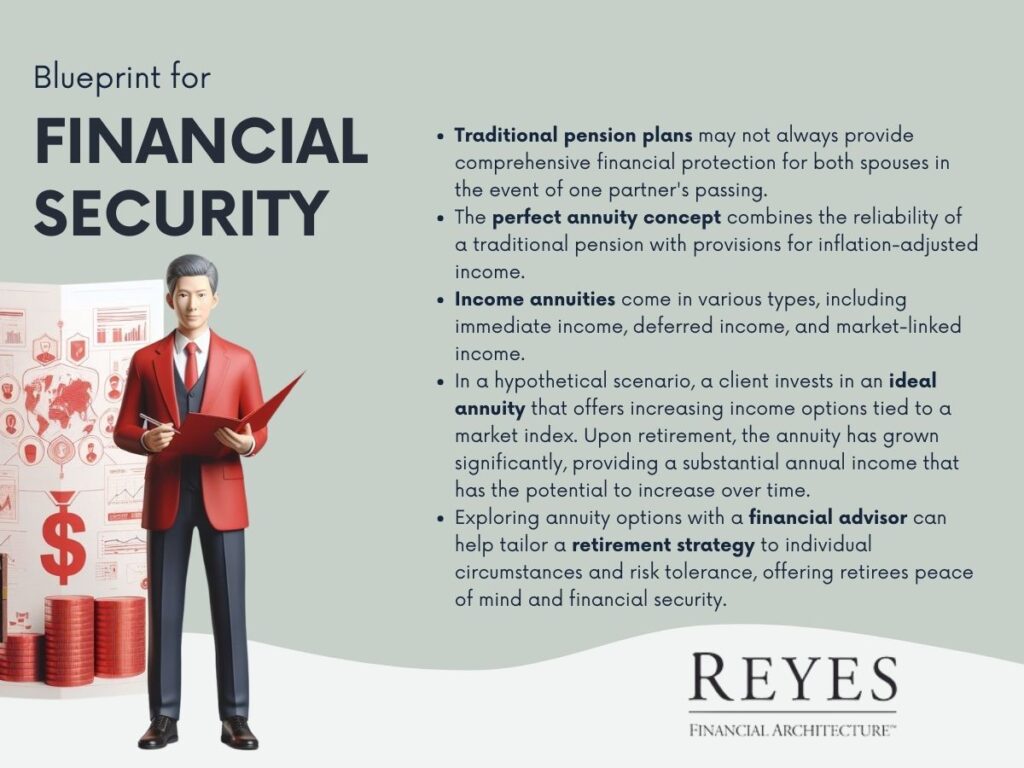
Conventional pension plans, although valuable, do not always guarantee equal income protection for both spouses in the unfortunate event of one's passing. Typically, the surviving spouse receives reduced or no pension income when one partner passes away.
Given that, statistically, husbands tend to predecease their wives, this discrepancy leaves the surviving spouse financially vulnerable. It underscores the need for an alternative financial solution that ensures guaranteed income for both individuals throughout their lifetimes.
The perfect annuity concept, which we will explore further, combines the strengths of a traditional pension with provisions for inflation-adjusted income. While it's essential to acknowledge that no financial product is entirely devoid of risks, we will provide a hypothetical example to illustrate the potential advantages of this concept.
Before delving into the hypothetical scenario, it's vital to understand the broad categories of income annuities:
Now, let's consider a scenario where a client invests a substantial sum in an ideal annuity that offers increasing income options tied to a market index. The client decides to defer their annuity for a specific period, aiming to retire at a later date.
Upon reaching retirement age, the annuity has grown significantly in value. The client can then choose to withdraw a percentage of the annuity value, resulting in a substantial annual income. This income represents a significant percentage of the original investment, providing financial security throughout their lifetime. Furthermore, this income has the potential to increase over time, providing protection against the erosive effects of inflation.
While the perfect annuity concept discussed in this article serves as a hypothetical example, it illustrates the potential benefits of merging the dependability of a traditional pension with provisions for income growth to counteract inflation. Such financial tools can offer retirees peace of mind, knowing they will receive a consistent income stream throughout their retirement years, with the added benefit of potential income growth.
It's essential to consult with a financial advisor to explore annuity options and tailor them to individual circumstances and risk tolerance. While the ideal annuity may not be suitable for everyone, it remains an intriguing concept for those seeking to secure their financial future and enjoy a retirement free from financial worries.
In this article, we will explore the dynamics of the stock market and provide insights into its recent performance, potential risks, and important considerations for investors. While we often focus on various aspects of financial planning, it's crucial to address the current state of the market, especially given the unprecedented bull run we've witnessed over the past decade.
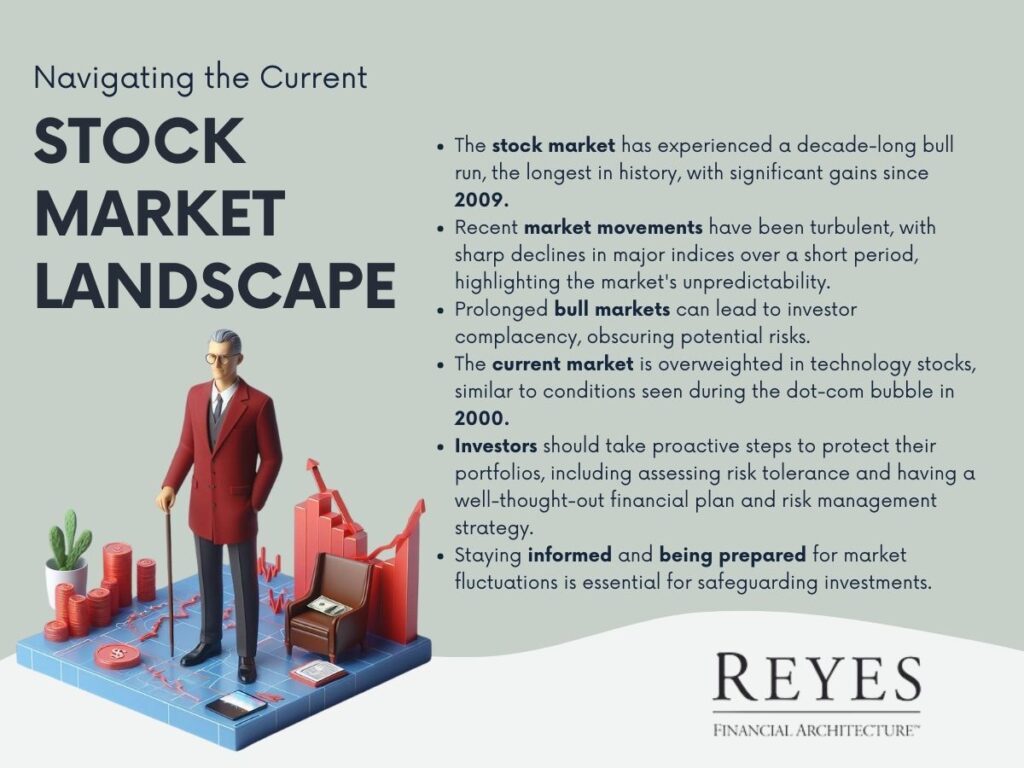
The stock market has experienced an exceptional 10-year bull run, marking its longest duration in history. Since 2009, the market has surged by more than 330%. To put it into perspective, if we were to compare this to a baseball game, we would be in extra innings.
However, the prolonged period of growth raises concerns and highlights the importance of being prepared for potential challenges ahead.
Recent market movements have been quite turbulent. For instance, in just three days in October, the Dow Jones Industrial Average experienced a sharp decline of 1,500 points, resulting in a 7% loss. The S&P 500, which had been up 9% year-to-date, saw its gains dwindle to nearly flat at just 1%. The Nasdaq also faced a 9% drop, with major tech companies like Netflix and Amazon witnessing substantial declines of 15% and 13%, respectively. These significant fluctuations occurred within a single week, emphasizing the market's unpredictability.
One of the primary concerns during a prolonged bull market is investor complacency. The more the market thrives, the more complacent investors tend to become. This complacency can be dangerous because it often obscures the potential risks that lie ahead.
As the famous adage by Warren Buffett goes, "When others are fearful, be greedy, and when others are greedy, be fearful." Currently, there seems to be a general eagerness to invest in the stock market, particularly in the tech sector.
The S&P 500 is currently overweighted by approximately 30% in technology stocks. This means that a significant portion of the S&P 500's value is attributed to technology companies. This level of overweighting in technology reminds us of the dot-com bubble in 2000, which led to an 80% decline in tech stocks.
Similarly, during the financial crisis, the S&P 500 had about 25% of its value tied to financial stocks, which subsequently lost 80%. The current overvaluation in technology stocks should not be underestimated.
Given the current market conditions and the looming risk of a downturn, it is crucial for investors to take proactive steps to protect their portfolios. While the idea of a bear market may seem alarming, it's essential to be prepared for potential losses ranging from 30% to even 50-60%. Being proactive and adequately prepared is the key to safeguarding your investments in such scenarios.
In conclusion, it is vital for investors to stay informed, assess their risk tolerance, and be ready to adapt their investment strategies in response to changing market conditions. Regardless of market circumstances, it is prudent to have a well-thought-out financial plan and risk management strategy in place. Your financial well-being is of paramount importance, and being prepared for market fluctuations is a responsible approach to safeguarding your investments.
Watch this informative and interactive video to learn more about our services!
In the complex world of finance, selecting a qualified financial advisor is crucial for ensuring effective management of your financial assets. Financial industries, recognizing the need for establishing benchmarks of excellence, have developed various accreditation programs.
These programs serve as a beacon, guiding individuals in choosing competent financial advisors equipped with the necessary skills and knowledge. Below is an overview of some prominent designations you should consider when selecting a financial advisor.
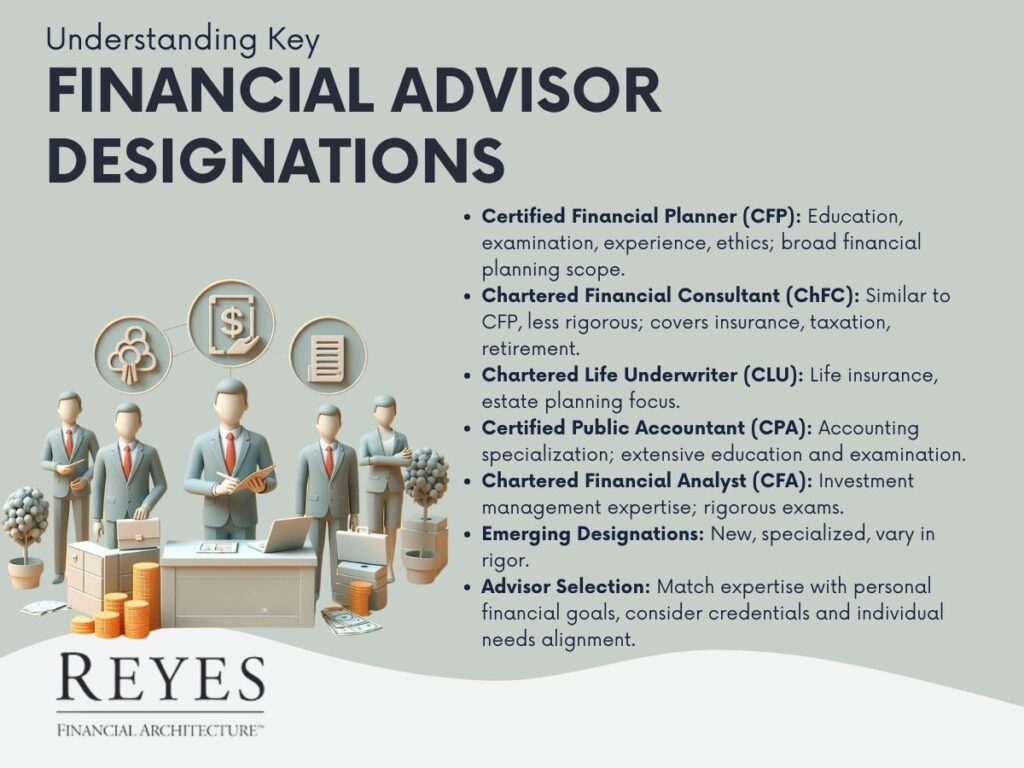
The Certified Financial Planner (CFP) is among the most sought-after designations in financial planning. To earn the CFP title, candidates must excel in four core areas: Education, Examination, Experience, and Ethics.
This comprehensive approach ensures that CFP professionals are well-equipped to offer sound financial planning advice. They undergo rigorous academic training, covering a wide range of topics including retirement planning, estate planning, risk management, and tax planning.
The examination phase is exhaustive, testing their practical application skills and theoretical knowledge. Furthermore, they must accumulate substantial real-world experience before they can be certified. Finally, adherence to high ethical standards is mandatory, ensuring that a CFP acts in the best interest of their clients.
The Chartered Financial Consultant (ChFC) designation is similar to the CFP in many respects, particularly in the depth and breadth of financial knowledge required. However, one key difference is the absence of a comprehensive board examination in the ChFC certification process.
ChFC professionals specialize in all aspects of financial planning, including insurance, income taxation, retirement planning, investments, and estate planning. This designation is often pursued by professionals who wish to deepen their understanding of financial planning without undergoing the CFP’s rigorous examination process.
The Chartered Life Underwriter (CLU) is the premier designation for professionals specializing in life insurance and estate planning. Regarded as the most respected insurance designation, the CLU equips professionals with in-depth knowledge of various life insurance products and a comprehensive understanding of the legal, financial, and tax aspects of estate planning.
This designation is particularly valuable for individuals seeking expert guidance in life insurance and estate management.
A Certified Public Accountant (CPA) is a professional who has excelled in the realm of accounting. To attain the CPA designation, one must complete the required college courses, earn a bachelor’s degree, and pass a rigorous 19-hour examination spread over two days. CPAs specialize in various aspects of financial management, including taxes, auditing, and bookkeeping. Their expertise is particularly vital in navigating complex tax laws and ensuring accurate financial reporting and auditing.
The Chartered Financial Analyst (CFA) designation is highly coveted in the field of investment management. To become a CFA, candidates must undergo a demanding course of study and pass a series of challenging exams.
The focus of the CFA program is investment analysis and portfolio management. CFAs are renowned for their expertise in financial analysis, valuation, asset management, and the application of ethical and professional standards in investment management.
The financial industry is constantly evolving, leading to the emergence of new designations. While these new credentials may offer specialized knowledge in certain areas, it's important to note that not all are as rigorously tested as the CFP and CPA designations.
As the financial landscape becomes increasingly complex, these designations play a pivotal role in defining the standards of professionalism and competence.
Choosing a financial advisor with the right designation is a crucial step in ensuring that your financial needs are adequately addressed. Each designation signifies a different area of expertise and a different approach to financial management.
It's essential to select a professional who not only holds a relevant designation but also understands your unique financial situation and goals. Look for advisors who are committed to aligning their expertise with your specific needs.
When selecting a financial advisor, the array of designations can be overwhelming. However, understanding these key designations – CFP, ChFC, CLU, CPA, and CFA – can significantly aid in making an informed choice. Remember, the right financial advisor is not just about credentials; it's also about finding someone who can tailor their expertise to your individual needs.
Always inquire about their experience, their approach to financial planning, and how they intend to meet your specific requirements. With the right advisor, you can navigate the complexities of financial planning with confidence and clarity
.
Click the video above to follow along as David Reyes, The Retirement Architect provides insightful information on Annuities
In today's ever-changing financial landscape, planning for retirement has never been more critical, especially as we live longer lives than previous generations. The need for a guaranteed lifetime income has become paramount. In this article, we will delve into the world of annuities and their role in securing your financial future.
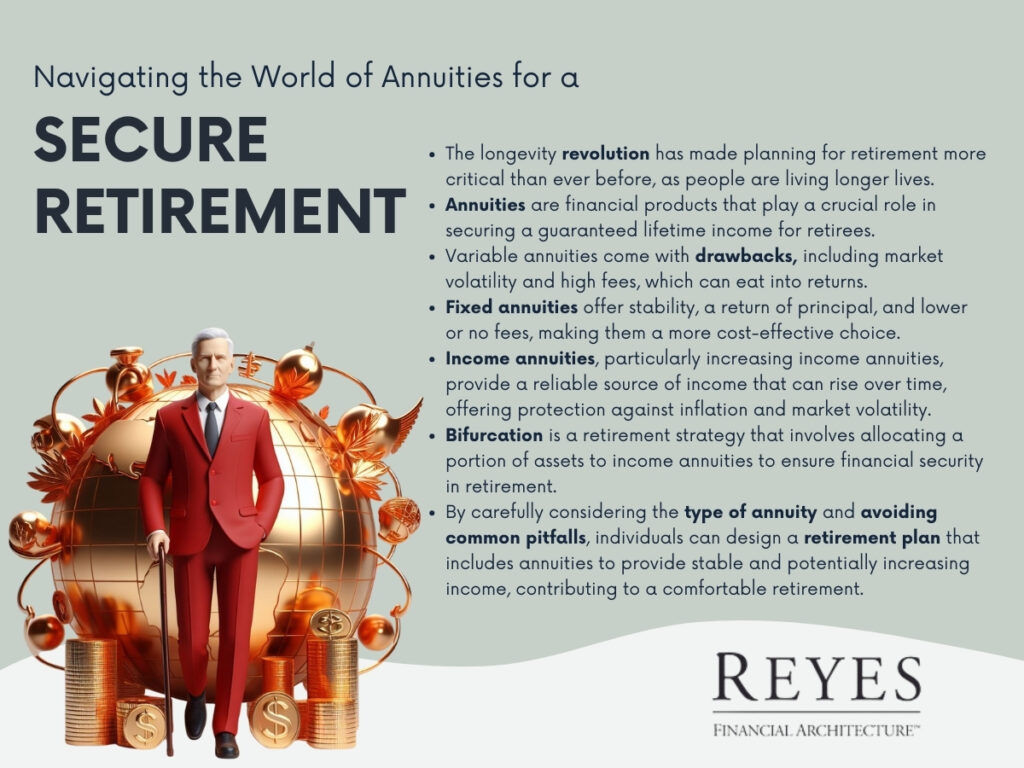
The 21st century has brought about a remarkable revolution – the longevity revolution. On average, people today live 34 years longer than their great-grandparents, leading to a second lifetime, complete with unique financial challenges and opportunities.
Annuities have garnered both praise and criticism in the financial world. To better comprehend this topic, let's explore the various aspects of annuities.
Annuities come with their share of drawbacks. Variable annuities, as the name implies, can be quite volatile, leading to uncertainty for investors. One of their major downsides is the high fees, which can amount to as much as three or four percent annually. To put it in perspective, a $500,000 annuity could accrue $20,000 in annual fees alone, necessitating a 4% return just to break even.
To avoid these pitfalls, many investors opt to replace variable annuities with fixed annuities. Fixed annuities offer stability and peace of mind, guaranteeing the return of your principal and shielding your capital from market volatility. The key distinction is that fixed annuities come with lower or even zero fees, offering significant cost savings over time.
Now, let's focus on the positive side of annuities. Given the longevity revolution, the most significant concern for retirees is outlasting their income. This fear is justified, especially for those relying on assets like stocks and bonds, which can be vulnerable to market fluctuations, significantly impacting retirement income.
To mitigate this risk, retirees often employ a strategy called bifurcation. This approach involves dividing assets into two categories: one designated for growth and the other for income. By allocating a portion of assets to income, typically around 30% to 60%, retirees can ensure a steady stream of funds to cover essential expenses, providing financial security in retirement.
Fixed income annuities play a crucial role in this strategy, offering guaranteed lifetime income—a lifeline in retirement planning. Traditional annuities provide level payouts throughout their lifetime, but there's a variant: increasing income annuities. These annuities offer both guaranteed lifetime income and the potential for rising payments over time.
Consider a scenario where you retire at 65 and secure a guaranteed lifetime income of $69,495 annually from a $1 million annuity. After a decade, your income from the same annuity has increased to $90,000 annually—a remarkable 25% growth. Increasing income annuities serve as a robust defense against inflation, healthcare costs, and market volatility, providing peace of mind during retirement.
As we navigate the longevity revolution, securing a stable and potentially increasing income in retirement becomes crucial. Annuities, when chosen wisely, can be a valuable addition to your retirement portfolio. By steering clear of the pitfalls associated with variable annuities and embracing the benefits of fixed and increasing income annuities, you can design a secure retirement plan. It is essential to plan diligently, stay informed, and consider the role annuities can play in your financial future as you prepare for a comfortable retirement.
The Little Red Book of Retirement Chapter 1
Retirement planning is a topic of paramount importance, especially for high net worth individuals. The first chapter of "The Little Red Book of Retirement" offers critical insights into the unique retirement planning needs of these individuals. This chapter lays the foundation for understanding how high net worth clients can strategically manage their wealth for a secure and fulfilling retirement.
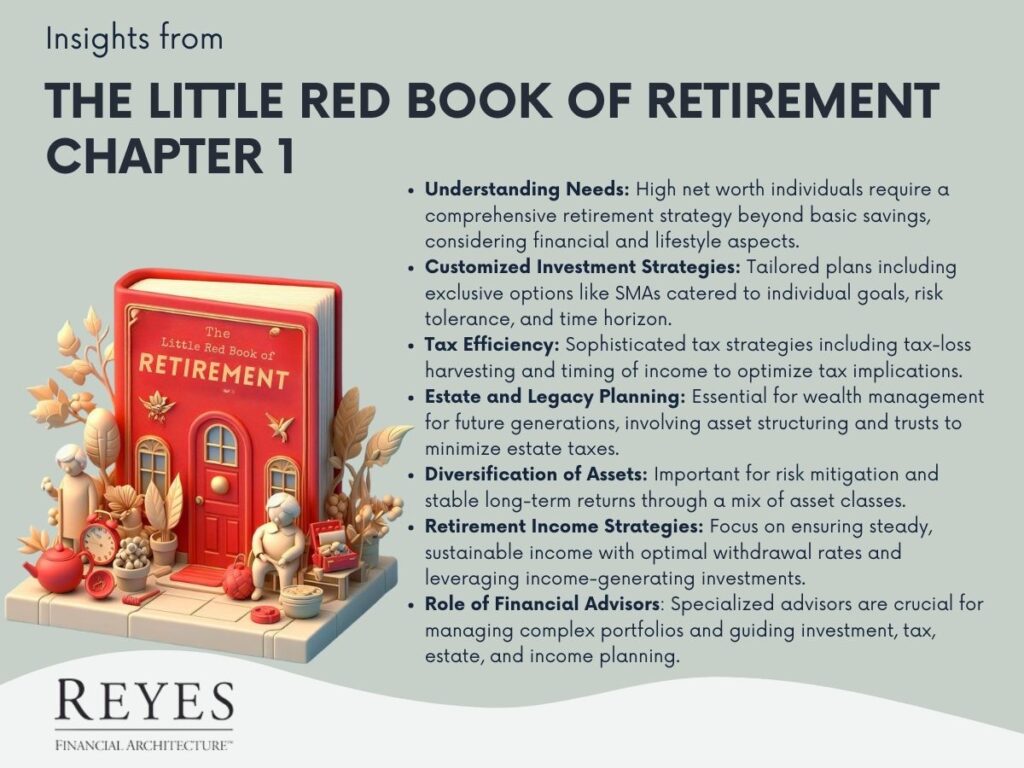
High net worth individuals, typically defined as those with a net worth exceeding $1 million, face unique challenges and opportunities in retirement planning. This chapter emphasizes that their retirement strategy needs to go beyond basic savings and investment plans. It should encompass a comprehensive approach that considers various financial and lifestyle aspects.
The first chapter of the book underscores the importance of partnering with specialized financial advisors. These professionals bring expertise in managing complex financial portfolios and can provide invaluable guidance on investment strategies, tax planning, estate management, and retirement income planning.
Chapter 1 of "The Little Red Book of Retirement" provides a comprehensive overview of the critical aspects of retirement planning for high net worth individuals. It emphasizes the need for a tailored approach that addresses the specific financial and lifestyle goals of the affluent. By understanding these key principles and working with experienced financial advisors, high net worth individuals can effectively navigate the challenges of retirement planning, ensuring financial stability and a fulfilling post-career life.